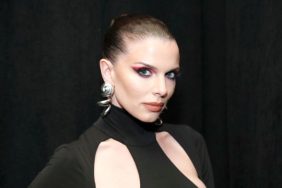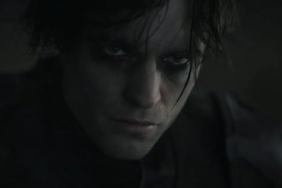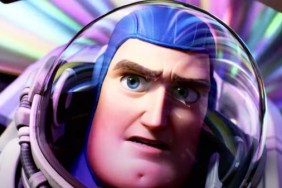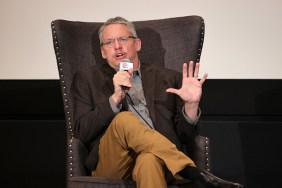Maleficent may tell the story of the villain from Disney’s animated classic Sleeping Beauty, but it does not tell the version you already know. In fact, with the exception of the scene where Princess Aurora is cursed, it’s almost entirely different. First-time feature film director Robert Stromberg, who has an extensive list of visual effects credits, was put in charge of re-interpreting the tale of Maleficent as the story of a fairy woman (Angelina Jolie) violated by King Stefan (Sharlto Copley), who curses his daughter as an act of revenge. But as the young girl grows up, Maleficent finds her dedication to vengeance challenged, and is forced to find a way to redeem herself after committing an unspeakable act herself.
Director Robert Stromberg was hesitant to say what he really thought of the origin of Maleficent as depicted in his film, but he did describe it as being “as traumatic as the worst thing that can happen to a woman,” and left that statement open to interpretation. We asked the director to elaborate on the meaning behind many of the changes to the original story found in Disney’s Maleficent, coming to theaters on May 30, 2014. Mild spoilers may follow.
CraveOnline: Maleficent is kind of a big deal. Was the script already in place when you came on, or did you help develop it?
Robert Stromberg: We had a script, we did sort of mold and correct that a little bit before we got to the shooting phase. I think what we did is, we shot the script, and we realized that we wanted to get to the meat of the story a little quicker, so…
Was Angelina Jolie’s change into [a villain] the 2nd to 3rd act changeover?
Yeah, it was.
Wow.
And we wanted to get to her much sooner, so what we ended up doing is we shortened… I think it was about an hour and fifteen minutes, and we wanted to get it under two hours. So we cut about fifteen minutes out of the first act, and then that had to be seamed together with some pretty basic reshoots. But no, we had a script but like any situation, when you’re on the set and you have all of the players there, and you do something, sometimes it looks better on paper. So we’d always adapt and add and do things to make it more interesting and fun.
When you were truncating the opening to get to the meat of the story sooner, is that why there is a lot of voice-over, so you can be more direct in the storytelling? Or was that always present?
Well, that’s part of it. I think it lends itself more to a fairy tale, a voice over does, more than other types of films, but we spent a bit more time originally in the fairy world before we got into the human side of things. And people have been asking so I might as well say that that is the section where Peter Capaldi and Miranda Richardson were [before they were cut from the film]. The script has always been the script, but as any script does it sort of molds a little bit and changes along the way.
The script sort of fascinates me, because the script has to incorporate some facets of Disney’s Sleeping Beauty, but you go in some very different directions.
Yeah.
Some of them as simple as renaming Flora, Fauna and Merryweather. Can you tell me where that decision came from?
I think you’d have to ask Linda [Woolverton] that question. Honestly, I’ll just let you ask her.
Fair enough. Well let me ask you about their interpretation, because dramatically they are handled very differently. Whereas in the original film they’re funny, but in many respects they’re the heroes, and here they’re very sidelined and almost comic relief, although well intentioned.
Well, as you know now, our story is about the relationship of Aurora and Maleficent, and what we wanted to do was focus on this search for the essence or definition of what love is. “True love’s kiss,” love and true love in general. When we approached this we didn’t want to do a complete, straight out of the box remake of the Disney classic, and I think by exploring other areas that forcefully changed some things, but other times, and other situations… As you know now there will be some people who don’t approve of some things, and some people accept it. The new generation of [the] audience will accept it as new. But we wanted not to just follow the same path. We wanted to throw some curveballs.
Well, you give yourself that out by saying that this is not the version of the story we’ve been told.
Yeah.
Which makes me wonder who’s been telling that version, because it seems like the differences are so dramatic. Is it Knotgrass, Flittle and Thistlewit spreading the old version, where they are the heroes and got the prince to kiss Aurora?
Well, you know, obviously because of the storyline and the direction that we went, that no longer was crucial to the story. What was crucial was how Maleficent deals with, because it’s from her side of the story, how she deals with the curse’s inevitability. So they had to become sort of sidelined characters to some degree. They’re still ditzy…
I think the crux of my question was, who is telling the original story? Did you ever read that storybook, The True Story of the Three Little Pigs?
No…
Well, it’s the story of the wolf, and he tells his version of it where he was just trying to borrow a cup of sugar, and then he sneezed and it was big mistake, but the pigs tell their version. So I’m curious who’s been telling the version of the story where Maleficent is evil if, within the film itself, you’re admitting we’ve heard a version of the story where Maleficent is evil?
Well, you know, look, she’s betrayed, right? She’s betrayed, and you can say “evil” and you can say “vindictive” and you can say “very upset,” you can say a lot of things. Is she spawned from the devil himself? No. So evil is interpreted by different people in many different ways. If we were to make a movie about a character who was just 24/7, evil-devil character, it would be very one-sided.
I’m not accusing her of being evil, I’m just curious that… if the version of the story of Sleeping Beauty that we saw in the original film exists within this film as a version you may have heard, since that’s one of the first lines of dialogue, I’m just curious how that version got out.
[Laughs.]
That’s my question. Maybe it’s a silly question.
Is it? I don’t know. It is our best attempt of a retelling of something that we’re really familiar with.
Well, I thought it was a really interesting retelling. I do want to clarify that. The story of a woman betrayed can take on a lot of different forms, many of them very, very dark.
A woman scorned can be the devil herself.
Granted. But there’s a woman scorned and then there’s a woman violated, in a lot of ways, metaphorically and physically.
Look, I mean… I’m not going to say what I really think, but it is as traumatic as the worst thing that can happen to a woman.
That was my interpretation when I saw it.
And it is absolutely true, and I won’t… You can interpret what I just meant by that, and it really comes through as this tragic betrayal and something that could really drive somebody to the point of doing anything, and then making [a] mistake because they’re deluded by that.
I think that’s fascinating, because it’s impossible not to have sympathy for Maleficent after that. In terms of how you were going to make her interesting, how you were going to make her heroic without denying what she actually did in the original version of the story, and just by giving her the best justification possible…
I would say that if Aurora weren’t in the picture, that [Maleficent] would just probably continue on forever just 24/7 as this bitter, evil character. But the interesting part for me is to pull somebody out of the depths of hell, and ironically using as the source, the light from the enemy.
And the structure interests me, because that’s the sort of thing you could very easily have saved for the very end. Just, “Oh, I realized I was wrong. Whoops!” But here the majority of this film is the path to realizing that that was a bad time for her, and she made a poor choice.
But we all do that. I think that’s what I was trying to do and what we were trying to do, is kind of play with what every one of us in real, everyday life, these insane emotions and insane mistakes that we make. Not to this degree, but you know what I mean, and how these decisions and mistakes steer our own future. We all have done things that we hate, we all have done things that we regret, and hopefully some of us have been redeemed and find ourselves again, and others don’t. The sort of juicy irony here is that she finds redemption through the spawn of her enemy.
I think there are ways to look at it where she’s a surrogate mother to Aurora, or you could look at her as just a sort of fairy godmother, and the friendship could go deeper than that or in other directions, depending on how you want to interpret. It’s very allegorical.
I think so. You know in real life Angelina [Jolie] has adopted children, and true love can cover many categories I think, and part of the message here is also that the prince [is not the solution], part of the message is, don’t be sure in your 16-year-old body that you know what love is.
That’s a great message.
Maybe it’s what you’re not looking at, which is somebody who’s there unconditionally.
There is question of how do we define true love? Is true love romantic, is the only kind of true love familial, or is it a combination of the two, because then the film can take on some very interesting [connotations]?
Well that’s it, and I try to leave the person leaving the theater asking that question, themselves. Because we all don’t know. I know, being a father myself, what my interpretation of true love is, or the essence of love, and you can apply it to other things besides human beings. Is making a movie true love, if you’re a creative person? It could be. But in my world the importance of being a father and having kids and knowing that connection is true love. Making a movie is love.
William Bibbiani is the editor of CraveOnline’s Film Channel and the host of The B-Movies Podcast and The Blue Movies Podcast. Follow him on Twitter at @WilliamBibbiani.







